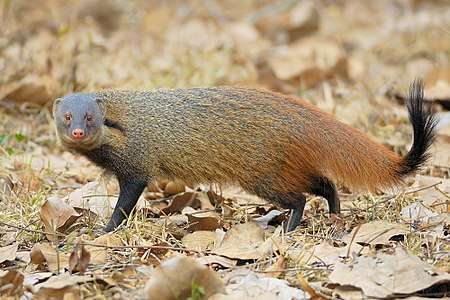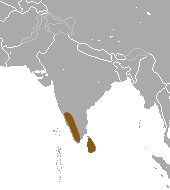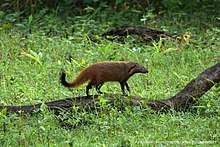Stripe-necked mongoose
The stripe-necked mongoose (Herpestes vitticollis) is a mongoose species native to forests and shrublands from southern India to Sri Lanka.[1]
| Stripe-necked mongoose | |
|---|---|
 | |
| Adult in Nagarhole National Park | |
| Scientific classification | |
| Kingdom: | Animalia |
| Phylum: | Chordata |
| Class: | Mammalia |
| Order: | Carnivora |
| Suborder: | Feliformia |
| Family: | Herpestidae |
| Genus: | Herpestes |
| Species: | H. vitticollis |
| Binomial name | |
| Herpestes vitticollis Bennett, 1835 | |
 | |
| Stripe-necked mongoose range | |
Characteristics

It is rusty brown to grizzled grey, has a stout body and short legs, a black stripe that runs laterally on both sides of its neck. Its short tail is mostly black, but grey at the base.
Distribution and habitat

The stripe-necked mongoose is distributed in the Western Ghats and in Sri Lanka.[1] In 1911, one individual was observed in southern Andhra Pradesh.[2]
Behaviour and ecology

It is diurnal and feeds on frogs, crabs, mouse deer, hares, rodents, fowl, and reptiles.
Taxonomy
There are two subspecies. H. vitticollis vitticollis is from the provinces of Western Ghats, Coorg and Kerala, and has more of a reddish tint to its fur. The other, H. vitticollis inornatus, is found in the Kanara province, and lacks a reddish tint to its fur.[3]
See also
References
- Muddapa, D.; Choudhury, A.; Punjabi, G. A. (2016). "Herpestes vitticollis". The IUCN Red List of Threatened Species. IUCN. 2016: e.T41619A45208503. doi:10.2305/IUCN.UK.2016-1.RLTS.T41619A45208503.en.
- Allen, P. R. (1911). "Mungooses in the Eastern Ghats". Journal of the Bombay Natural History Society. 21 (1): 237–238.
- Balaji, K.; Satyanarayana, J. E. (2016). "The first record of Stripe-necked Mongoose Herpestes vitticollis Bennett, 1835 (Mammalia: Carnivora: Herpestidae) from the Eastern Ghats of Andhra Pradesh, India". Journal of Threatened Taxa. 8 (14): 9684–9686. doi:10.11609/jott.3123.8.14.9684-9686.
- Pocock, R.I. (1941). The fauna of British India, including Ceylon and Burma. Mammalia, 2nd Edition, 2. Taylor & Francis, London, U.K.
- Prater, S. H. (1971). The Book of Indian Animals – 3rd Edition.Bombay Natural History Society. Oxford University Press, Bombay, 324pp.
- Corbet, G.B. & J.E. Hill (1992). Mammals of the Indo-Malayan Region: A Systematic Review. Oxford University Press, Oxford, UK.
- Van Rompaey, H. & Jayakumar, M. N. (2003). The Stripe-necked Mongoose, Herpestes vitticollis. Small Carnivore Conservation 28: 14–17.
- Mudappa, D. (2013). Herpestids, viverrids and mustelids, pp. 471–498. In: Johnsingh, A.J.T. & N. Manjrekar (eds.). Mammals of South Asia -1. Universities Press, Hyderabad, India.
- Menon, V. (2014). Indian Mammals - A Field Guide. Hachette India, Gurgaon, India, 528pp.
- Sreehari, R. & P.O. Nameer (2016). Small carnivores of Parambikulam Tiger Reserve, southern Western Ghats, India. Journal of Threatened Taxa 8(11): 9306–9315; https://dx.doi.org/10.11609/jott.2311.8.11.9306-9315
- Nayak, A.K., M.V. Nair & P.P. Mohapatra (2014). Stripe-necked Mongoose Herpestes vitticollis in Odisha, eastern India: A biogeographically significant record. Small Carnivore Conservation 51: 71–73.
